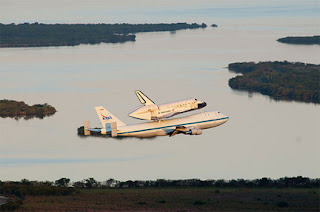.
Spectacular Flight over Nation's Capitol Slams Door into Space
President Obama decided the NASA Space Program was unnecessary and he terminated over 30 years of American dominance in space. We now have to hitch rides on Russian rockets to even reach the International Space Station.
Today was bittersweet for space enthusiasts as Discovery took it's last flight
The Space Shuttle Discovery is the longest-serving orbiter. It was flown 39 times from 1984 through 2011 — more missions than any of its sister ships — spending altogether 365 days in space. Want to know more about the Discovery?
• In 2000, the Discovery flew 100th shuttle mission.
• Discovery launched on its final flight to the International Space Station on the STS-133 mission February 24, 2011.
• Three Hubble Space Telescope flights (1990 deployment and 2 servicing visits, 1997, 1999).
• Two flights were to the Russian space station Mir (1995, 1998).
• Thirteen flights went to the International Space Station (1999-2011).
• It orbited the Earth 5,830 times and traveled 148,221,675 miles.
A bit more trivia about the Space Shuttle Discovery:
The shuttle was named after other famous ships of exploration, such as the HMS Discovery which accompanied English explorer James Cook and Henry Hudson’s ship Discovery, which he used to look for the Northwest Passage .
A rather famous fictional spaceship from Stanley Kubrik’s 2001: A Space Odyssey is named Discovery One. You may not remember that, but I bet you remember the name of the onboard computer: HAL 9000.
In 1998, Discovery carried astronaut (and senator) John Glenn, who was 77 at the time, back in space, giving him the record of oldest person to go into space. Incidentally, this also made him the third seated politician to fly in space.
Utah Senator Jake Garn is the first sitting member of the United States Congress to fly in space. He was the payload specialist onboard Discovery’s STS-51-D mission in 1985. The second seated politician to fly in space is then Florida Representative (now Senator) Bill Nelson, who flew in 1986 onboard the Space Shuttle Columbia.
Jake Garn was also the world’s first space tourist. Actually, was also a guinea pig: his mission was to be subjected to tests designed to increase understanding of space motion sickness. He had motion sickness so severe that NASA named the "Garn scale" of space sickness after him. Upon his return to Congress, his Senate colleagues and promptly called him by his new nickname: "Barfin’ Jake" (bestowed by cartoonist Garry Trudeau in his Doonesbury strip).
President Bill Clinton watched John Glenn’s return to space from the Kennedy Space Center , making him the first (and only) US
Discovery also carried the first (and so far only) member of royalty in space: Sultan bin Salman bin Abdulaziz al-Saud, grandson of King Ibn Saud of Saudi Arabia
Space Shuttle Discovery was the first shuttle to fly after both the
Challenger and It’s not all fun and science onboard the Space Shuttle Discovery: it has carried many classified payloads. In one such mission in 1985, the shuttle crew reportedly launched a secret satellite for the Department of Defense and the National Reconnaissance Office called Magnum. Or so we heard.
Discovery was the shuttle that launched the Hubble Space Telescope and the Ulysses probe (designed to study the sun).
In 1999, Mission Specialist Daniel T. Barry brought along his favorite game, the first copy of computer game in space, StarCraft. The game CD now resides in Blizzard’s home office after orbiting the Earth 153 times and traveling 3.5 million nautical miles.
The external tank of the shuttle had to be repaired in 1995, due to damage done by birds! NASA discovered that Northern Flicker Woodpeckers pecked about 200 holes in the foam insulation on Discovery’s fuel tank.
They promptly installed noisemakers and physical deterrents to scare off the woodpeckers. Also, they added a permanent human "woodpecker spotters" at launch pads around the clock!In this mission, Discovery also carried Sweden
Farewell old friend...
.








